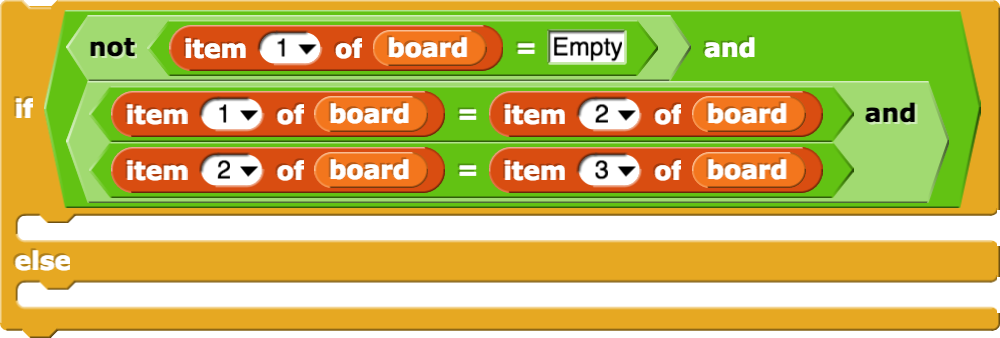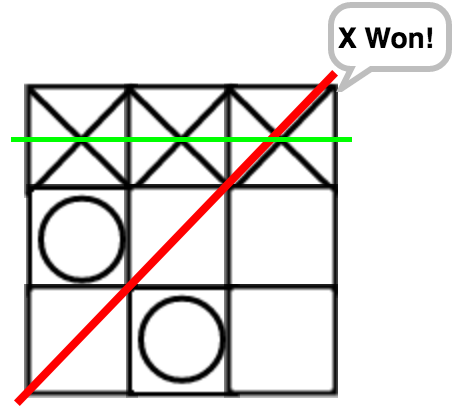Lab 3: Tic-Tac-Toe
Can we cut all this commented out text? --MF, 8/31/19
Content: idenitfying if someone has won the game
Goal: higher-order functions (learning
map for the first time; reviewing others)
- Selim is worried that this is too complex a context for the introduction to
map (Al and Mary agree.) - Big unsettled debate: Do we motivate HOFs are capstones to make life easier or do we start with them and use the details later?
In this lab, students will continue the Tic-Tac-Toe project by teaching the computer how to detect a win or a tie. To do this, the program must remember the moves that have been made. (In a sense, the program already does have that memory, but it is spread out among the nine sprite clones representing the individual squares. Here we add a model of the board in one place, so the program can reason about it.)
The capacity to remember and analyze moves will later be used to let the program make sensible moves as a player.
Pacing
The 3 lab pages could be split across 2–4 days (
65–130 minutes). Expected times to complete follow:
Lab Pages
-
Page 1: Remembering the Moves and Possible Wins.
-
Learning Goals:
- Understand how to use global variables to shift the knowledge in a program from a distributed form to a global view.
- Gain experience with lists.
-
Tips:
- The purpose of the preparatory activities on this page may not be immediately clear to students. Why do we need to have each square sprite have its own unique square number variable? Why do we create a global board variable when each sprite already knows if it has been clicked? The purpose should become clear on the next page, where students will learn how to use the global state of the board in order to detect wins and ties. If students seem to be losing the plot, ask them to think, without writing code, about how a program would know when someone has won the game.
-
Page 2: Detecting A Win.
-
Learning Goals:
- Refine the Tic-Tac-Toe game to declare a winner.
- Understand how having a global view of the game gives the program the ability to analyze moves.
- Gain experience with the higher-order function
map and have a taste of its enormous power to simplify code.
- Practice using the higher-order function
map in context.
-
Tips:
-
Page 3: Checking for Ties.
-
Learning Goals:
- Refine the Tic-Tac-Toe game to announce a tie.
-
Tips:
- Refining this game builds on students' understanding of lists and list operations including higher-order functions. This is likely to feel very satisfying to students. It is a major accomplishment!
- For this part of the problem, the board array we started with is more convenient than the
status of all winning triples form we used to detect wins. What students should take away from this is that they have the power to manipulate data into whatever form is most useful for solving each problem that arises. Don't let them feel frustrated because it's not obvious to them ahead of time what format is best in each case; that comes with experience.
Solutions
Correlation with 2020 AP CS Principles Framework
There are no AP CSP standards connected to this lab.




 block to test all the possible winning triples at once. It may not be obvious to some students that this block can have a list of lists as an input as shown below.
block to test all the possible winning triples at once. It may not be obvious to some students that this block can have a list of lists as an input as shown below.